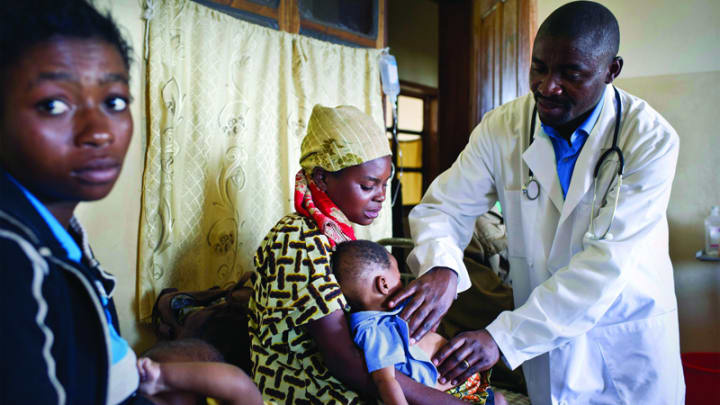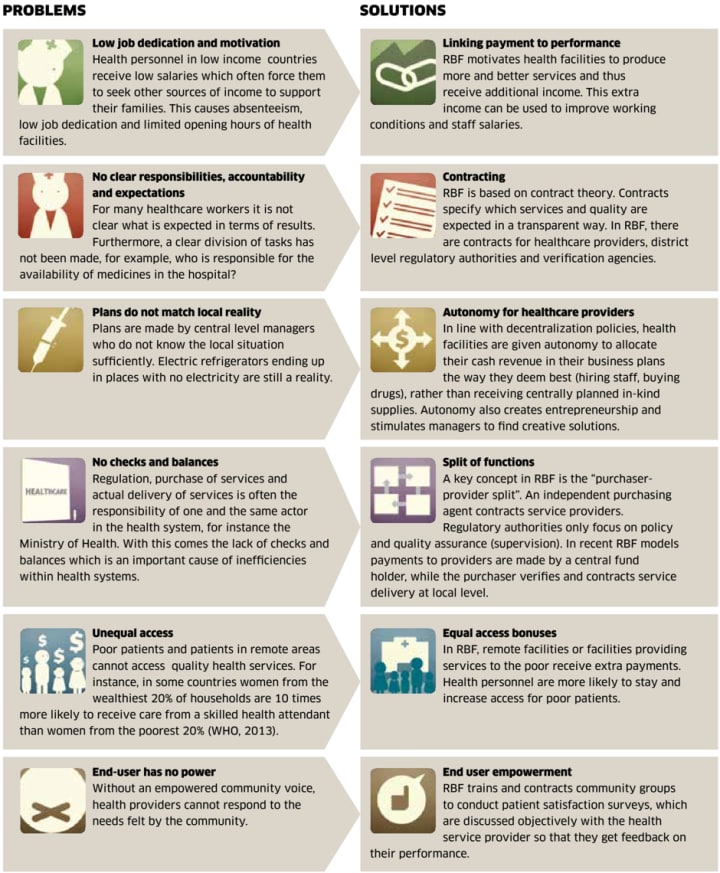
It’s been argued that results-based financing is showing a new way of doing health care, to “reward health service providers — often with money — for positive results.”
Two responses to this would be that, first, RBF approaches have been around for over 15 years, and therefore aren’t new. Second, we’d like to see more emphasis given to the fact that RBF is a qualitative approach, contributing to health systems strengthening in a major way.
So is RBF an approach that just focuses on paying for performance? Here are three insights that help complete the picture:
What is RBF in practice?
Results-based financing aims at improving health services for the poorest and most vulnerable people, especially those in isolated, rural areas. The essence of RBF is a direct link between funding and results. Contrary to a traditional input financing system, health care providers receive their payments only after their output has been verified. RBF is more than just a change in the way health care providers are paid: it is a health system reform strategy that is built on many years of experience with health system strengthening. It introduces checks and balances, motivates staff, promotes entrepreneurship and involves private parties as well as communities.
1. Freedom to organize.
RBF is built on insights that have been around for a long period of time, such as decentralization, contracting theory and organizational theory.
An example is the principle of autonomy derived from organizational theory: People, and specifically teams, will show higher motivation if they receive ample freedom to decide on how to organize their work.
Moreover, this will allow them to be more flexible and find solutions that better fit specific circumstances. If they see the results of their work, they will become even more motivated.
2. Cheaper, pro-poor and more efficient health systems.
From the World Bank’s impact evaluation of Cordaid’s Zimbabwe program, we concluded that RBF has benefited the bottom half of the population more than the upper half. It was calculated that in two to three years’ time, RBF can typically lead to an increase in universal health coverage in the catchment area of 5-10 percentage points.
RBF is also a more sustainable approach to health care financing as it is output-based rather than input-based, i.e. traditional aid. If host countries are willing and able to incorporate RBF in their health care financing strategy, they may use the same money in a more efficient and effective way.
For example, in the Cordaid program in Uganda, annual per capita spending is $1.50-$2 for a catchment population of 700,000. For the Ministry of Health of Uganda, the annual per capita spending is $10.40. So rather than topping up the $10.40, it is using the $10.40 in a more efficient manner such as with RBF. All depends on the choices made in the allocation of resources.
In addition, RBF uses contracting as a process to reward providers for their performance. This instrument can also be used in the long run, for instance in a situation where health care providers are paid by a national social insurance scheme.

3. Data and verification.
Data management and verification of results are crucial aspects of the RBF approach. Both quantity and quality output indicators at the health care provider level are measured and verified on monthly and quarterly bases. While the accurate assessment of quality care can present challenges, specifically in terms of measuring quality of complications of care, a well-implemented RBF program will assess the clinic-level quality of care through a balanced scorecard approach. Especially routine best practices relevant for every patient and structural quality care are effectively measured through the RBF approach.
Additionally, the perceived quality by patients is measured by conducting satisfaction surveys on a quarterly basis. Although the weight of these surveys is considerably smaller than the weight of the first assessment, the so-called technical quality, they are an important extra indicator.
A review of the RBF program in Zimbabwe in 2013 showed that including patient satisfaction scores motivated staff in facilities to start occupying themselves with the question “What do patients really expect from us and how do they look at our services?” This led to simple alterations in service delivery, including opening hours, positive staff attitudes, reduced waiting times, and more.
It should be clear from the above that RBF is built on lessons learned from years of health system strengthening programs. It is not simple to design an RBF scheme. There are well and badly designed schemes. The key is to learn from past experiences and to allow learning to take place within the program. And this is the core of RBF: monitoring the results thoroughly and translating this back into adjusted activities at all levels of the health system.
Making Markets Work is an online conversation to explore what’s being done to make global health care markets accessible to people at the base of the pyramid. Over 10 weeks, we will amplify the discussion around effective health financing, analyze key challenges blocking universal market access in the health care supply chain, and explore the key strategies to make markets more effective. Join us as we look at this important issue, and share your thoughts by tagging #MakingMarketsWork and @Devex.








